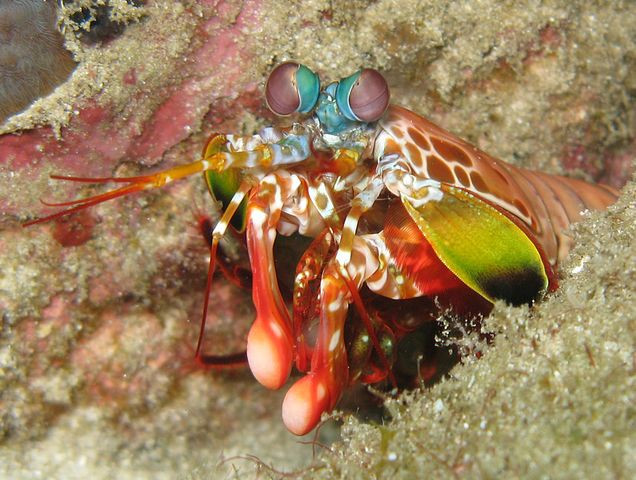The Week In Science: Mantis Shrimp Eyes, Dog Cancer and Nose Maggots

This week in science, we saw how bats follow ripples in water back to tasty frogs, heard about the new atomic clock that keeps time to one-430 trillionth of a second and found out why a marine biologist insists on tossing logs into the sea. But there’s a lot more discoveries that were unveiled this week; here’s a roundup to round out the week:
Scientists think they’ve discovered the dirty secret of ball lightning, a mysterious phenomenon where a glowing sphere appears suddenly, then just as quickly disappears. High-speed video and spectrograph data revealed that ball lightning seems to have the same chemical composition as soil -- supporting an old theory that ball lightning is superheated dirt hurled into the air by a lightning strike. [Ars Technica]
Some Rhode Island schools are attempting to warn kids away from snorting crushed Smarties candy by warning of a particularly gruesome side effect: nose maggots. It’s thought that bits of sugar lingering in the nose for a long time can provide food for bacteria, fungi and also maggots and worms. But has there ever really been an observed case of Smarties-induced nose maggots? A University of Pennsylvania ear, nose and throat doctor says he has seen maggots take up nasal residence after food has been snorted, but hasn’t seen the phenomenon with Smarties specifically. [Hard Deadlines]
Scientists traced a sexually-transmitted cancer in dogs to a single canine that lived 11,000 years ago. [Los Angeles Times]
The mantis shrimp seems like a superhero: brightly colored outfit, claws that can render prey unconscious with 200 pounds of force. Plus, he has eyes like no other animal on the planet, resembling satellite sensors more than anything else. The shrimp has 12 color receptors, compared to humans’ three, which might suggest it sees colors we can’t think of -- but actually, it may see less colorful details than other animals. The extra receptors may just be a way to process certain colors very quickly and help the shrimp identify prey more quickly. [LiveScience]
Better vegetables through genetics, but not through genetic modification: a fascinating look at how researchers are using rapid genetic analysis to breed brighter, more flavorful and more nutritious fruits and vegetables. No direct genetic manipulation required! [Scientific American]
A quarter of the world’s sharks and rays are facing the threat of extinction, thanks to overfishing. [Christian Science Monitor]
Electric cars alone can’t save the planet, according to a new study conducted by North Carolina State University researchers. Passenger vehicles contribute a relatively small share of total emissions -- about 20 percent of carbon dioxide -- and electric cars still contribute emissions indirectly, via the power plants that power them. Ultimately, even if 40 percent of cars in the U.S. are hybrids or electric, the scientists do not expect there to be any noticeable emissions reductions compared to a scenario with no electric cars at all. (However, the team notes that electrics and hybrids offer other benefits, such as improved local air quality and reduced dependence on foreign oil.) [The Verge]
© Copyright IBTimes 2024. All rights reserved.




















